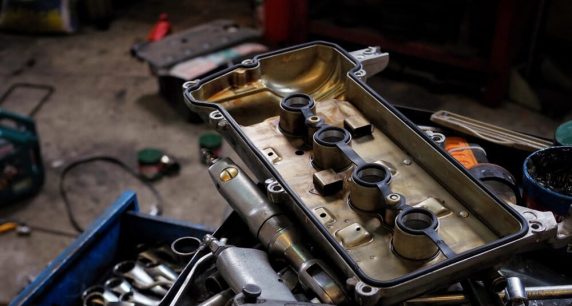The Function of a Valve Cover

A standard internal combustion engine is made up of numerous structural components, all of which are fitted together to function in an effortless fashion. However, these components must be sealed together to prevent fluid loss when an engine is in operation.
This seal is formed with the use of specialized gaskets, which have been cut or moulded to the exact dimensions necessary for proper fitment. In the past, gaskets of this nature were constructed from pressed fibre or cork, of varying thicknesses. Today, the vast majority of automotive gaskets are made of rubber coated plastic, or specialty fiberglass compounds.
One particular structural junction that requires the use of a gasket, is that which exists between an engine’s cylinder head(s) and valve cover gasket(s). A standard inline engine features one-cylinder head, while engines of a “V” configuration feature two heads.
These heads contain an engine’s valve train components (valves, valve springs, and rockers), which continually actuate to control the distribution of intake air into each cylinder, as well as the release of combustion gases into the exhaust tract. These valve train components are cooled and lubricated by a steady supply of engine oil.
Each cylinder head is capped with a valve cover, which was also referred to as a rocker cover in service literature of the earlier era. An engine’s valve covers prevent oil loss from the cylinder heads on which they reside, while simultaneously preventing debris from being deposited within.
Between each cylinder head and valve cover, resides a valve cover gasket, which provides a far more efficient seal, than that which would be provided by metal-on-metal fitment. Without a valve cover gasket, oil would readily leach from the junction between these two vital components.
VALVE COVER LOCATION

The valve cover is on top of the engine. It is a hard cover that protects the valves and other engine parts. Between the valve cover and the engine is a gasket, which creates a tight seal.
Because the gasket generally fails before the valve cover, this part is replaced more often. However, to get to the valve cover gasket, the valve cover must be removed.
The valve cover protects the vital components of the engine. It’s responsible for covering the valves, thereby protecting the expensive machinery from damage and the elements. However, the valve cover can suffer from misalignment, corrosion and cracks.
The valve cover works with the valve cover gasket to provide an effective engine seal. This thin rubber strip is placed between the engine and valve cover. However, the gasket is delicate and more prone to damage than the cover itself. Over time, it becomes brittle or cracks due to heat and old age.
HOW LONG SHOULD THE GASKET LAST?
The longevity of an engine’s valve cover gasket(s) largely depends upon several factors. These factors include the make of the engine in question, the frequency of standard engine maintenance, and the driving habits of a motorist.
Some OEM gaskets are naturally more durable than others, thereby providing a longer service life. Additionally, valve cover gaskets in a well maintained engine will almost always exhibit a higher level of durability than those that are neglected.
Additionally, gaskets found in the engine of a vehicle that is seldom driven, are more prone to premature failure, as they typically become dry and brittle.
However, on average, one can reasonably expect their engine’s valve cover gaskets to last for a period of 64,000-96,000 KM, with little to no issue. In some cases, gaskets of this nature can last considerably longer.




